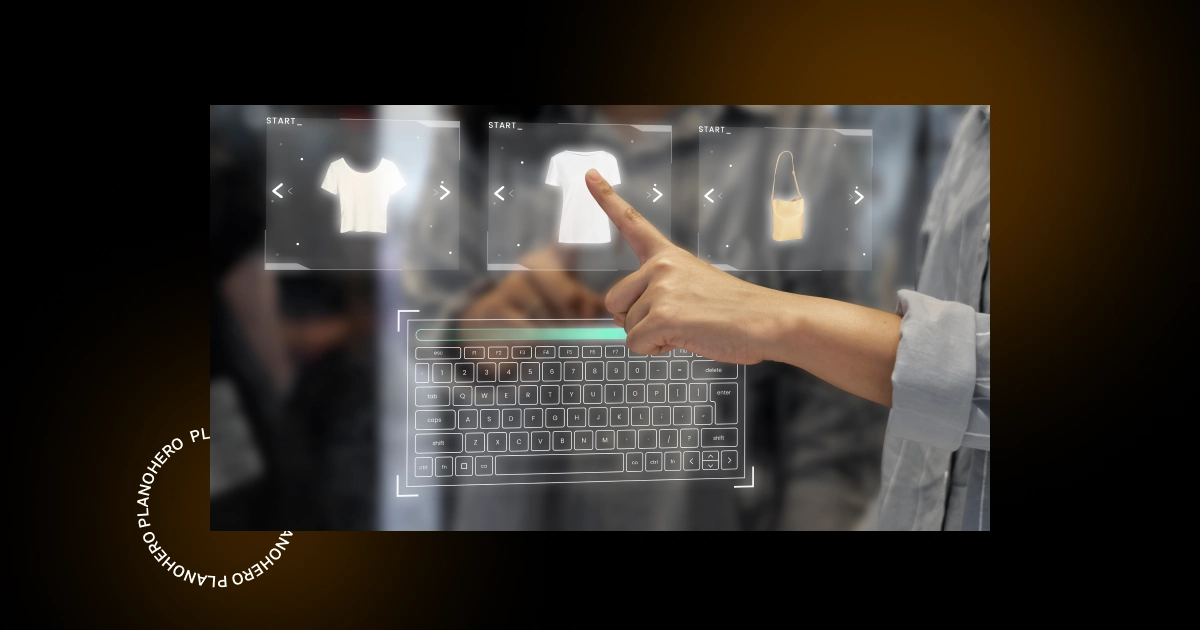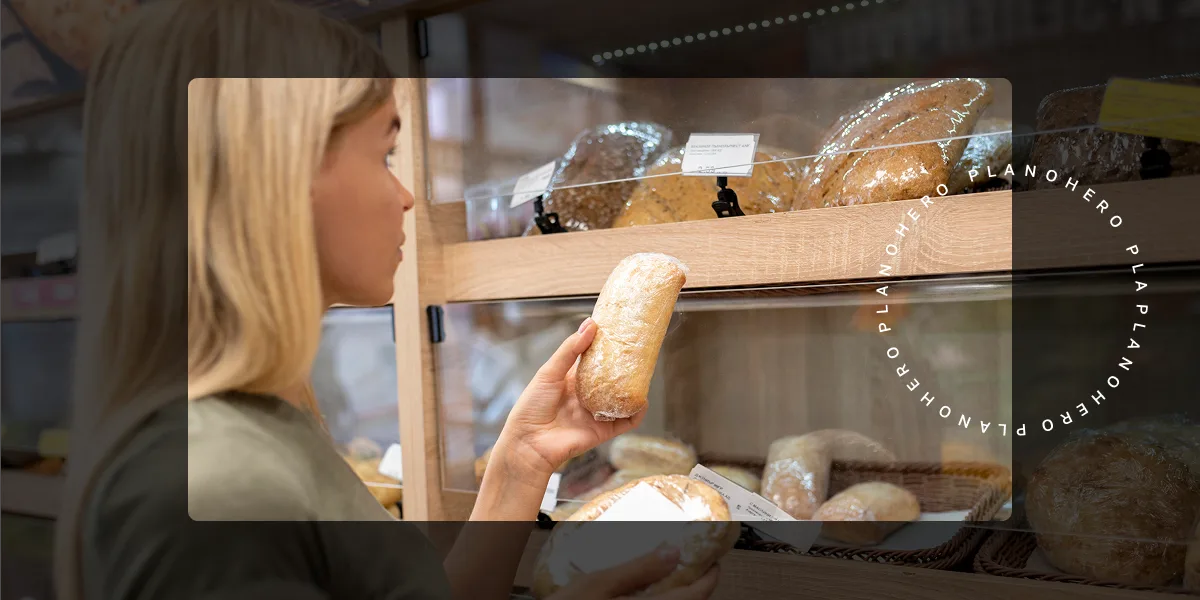W miarę jak oczekiwania konsumentów rozwijają się w zawrotnym tempie, detaliści muszą wyjść poza wybór między doświadczeniem cyfrowym a fizycznym — muszą je połączyć.
Phygital retail łączy sklepy stacjonarne i technologie cyfrowe w celu stworzenia bardziej spójnego i konsekwentnego doświadczenia zakupowego. W miarę jak oczekiwania klientów ewoluują, to podejście stało się kluczową strategią dla detalistów, którzy chcą pozostać istotni i konkurencyjni na współczesnym rynku.
Od kodów QR i luster z rozszerzoną rzeczywistością po zarządzanie zapasami w czasie rzeczywistym i aplikacje mobilne — phygital retail tworzy jednolity ekosystem, w którym każdy punkt kontaktu ulepsza ścieżkę klienta. Ale żeby to działało, potrzebne są odpowiednie technologie, właściwi ludzie i podejście oparte na danych, które stawia na pierwszym miejscu spersonalizowane, wciągające i spójne doświadczenie.
Czym jest phygital retail?
Phygital retail (Physical + Digital = Phygital) to połączenie środowiska handlu stacjonarnego i cyfrowego. Łączy ono dotykowe, zmysłowe doświadczenia zakupowe w sklepie z szybkością, wygodą i personalizacją handlu elektronicznego. Wykorzystując technologie takie jak aplikacje mobilne, inteligentne kioski, rozszerzona rzeczywistość i dane w czasie rzeczywistym, Phygital Retail umożliwia markom oferowanie klientom jednolitego doświadczenia zakupowego we wszystkich kanałach.
Przykłady:
- Zakupy online z odbiorem w sklepie
- Podgląd produktów z wykorzystaniem AR
- Kioski z nieskończonymi półkami
- Inteligentne lustra i cyfrowe oznakowanie
- Mobilne systemy płatności
- Spersonalizowane powiadomienia uruchamiane geolokalizacją w sklepie
Dlaczego strategie phygital są ważne w handlu detalicznym
Współcześni klienci nie myślą w kategoriach „kanałów”. Oczekują spójnego i wygodnego doświadczenia, niezależnie od tego, czy przeglądają produkty na telefonie, stoją w alejce sklepu czy przewijają media społecznościowe.
Właśnie tutaj z pomocą przychodzą strategie fizyczno-cyfrowe.
Przy odpowiednim podejściu:
- Łączą wszystkie punkty kontaktu z klientami w jeden system
- Zwiększają zaangażowanie i konwersję
- Zwiększają lojalność wobec marki dzięki hiperpersonalizacji
- Zwiększają elastyczność operacyjną i szybkość realizacji zamówień
Handel fizyczno-cyfrowy to nie tylko aktualizacja — to transformacja biznesu.
Kluczowe elementy udanego sklepu phygital
Tworzenie funkcjonalnego ekosystemu fizyczno-cyfrowego oznacza połączenie infrastruktury, ludzi i doświadczeń klienta wokół kilku kluczowych elementów:
-
Zarządzanie zapasami w czasie rzeczywistym we wszystkich kanałach
Dane w czasie rzeczywistym to podstawa operacji fizyczno-cyfrowych. Detaliści muszą zintegrować systemy na swoich platformach e-commerce, w sklepach stacjonarnych i na zewnętrznych platformach sprzedażowych, aby zapewnić dokładność i synchronizację zapasów. To wspiera takie możliwości jak:
„Kliknij i odbierz”
Dostawa tego samego dnia lub dostawa lokalna
Funkcja „nieskończonej półki” (zamawianie produktów, których nie ma w sklepie)
Technologie takie jak etykiety RFID, czujniki IoT i zintegrowane systemy POS odgrywają kluczową rolę w zapewnieniu płynnego połączenia między półkami fizycznymi a cyfrowymi.
-
Personalizacja oparta na danych i profilowanie klientów
Zbierając i łącząc dane ze wszystkich punktów kontaktu — aplikacji, stron internetowych, kiosków i sklepów stacjonarnych — detaliści mogą stworzyć pełny profil klienta. To pozwala im oferować:
- Spersonalizowane rabaty i promocje
- Rekomendacje produktów oparte na sztucznej inteligencji
- Oferty oparte na lokalizacji, aktywowane w sklepie
- Prognozowane uzupełnianie zapasów w oparciu o preferencje klientów
Kluczową rolę odgrywają tu platformy danych o klientach (CDP) i analityka oparta na sztucznej inteligencji. Na przykład stali klienci mogą otrzymywać indywidualne oferty w momencie wejścia do sklepu dzięki powiadomieniom push z geolokalizacją.
-
Ulepszanie doświadczenia w sklepie dzięki cyfrowym punktom kontaktu
Twój sklep stacjonarny to już nie tylko miejsce zakupów — to centrum doświadczeń. Detaliści powinni integrować technologie cyfrowe, które poprawiają i personalizują wizytę w sklepie:
Inteligentne lustra do wirtualnych przymiarek
Urządzenia AR/VR do wizualizacji produktów
Interaktywne cyfrowe oznakowanie i kioski
Mobilne terminale POS do elastycznych płatności
Takie technologie pomagają skrócić czas oczekiwania w kolejkach, zwiększyć zaangażowanie i poprawić efektywność obsługi, co daje twojemu sklepowi stacjonarnemu przewagę konkurencyjną.
-
Zunifikowane doświadczenie omnichannel
Kupujący chcą otrzymywać takie samo doświadczenie, niezależnie od używanego urządzenia czy lokalizacji. Zunifikowany system sprzedaży pozwala na:
Dostęp do koszyka zakupowego na różnych platformach (zacznij na telefonie, dokończ w sklepie)
Programy lojalnościowe obejmujące zakupy online i offline
Scentralizowane kanały wsparcia dla płynnej obsługi
Dokładne wyświetlanie zapasów i cen we wszystkich kanałach
Ostateczny cel? Naprawdę płynny proces zakupowy, który nie zmusza klienta do wyboru między sklepem online a stacjonarnym.
Kluczowe technologie umożliwiające działanie phygital commerce
Aby zapewnić płynną integrację między światem cyfrowym a fizycznym, detaliści muszą wdrożyć solidny zestaw technologii. Te technologie stanowią infrastrukturę strategii handlu fizyczno-cyfrowego:
Mobilne terminale POS (mPOS)
Systemy mPOS pozwalają sprzedawcom obsługiwać klientów z dowolnego miejsca w sklepie i:
- Eliminują długie kolejki
- Zapewniają obsługę klienta (spersonalizowaną pomoc)
- Synchronizują się z CRM, ERP i systemami zarządzania zapasami
- Wspierają płatności zbliżeniowe i płatności cyfrowe
Kioski w sklepach
Cyfrowe kioski pełnią rolę punktów samoobsługowych, które pozwalają klientom:
- Przeglądać cały katalog produktów
- Składać zamówienia na dostawę do domu
- Korzystać z nieskończonego asortymentu
Skanować kody lojalnościowe w celu otrzymania spersonalizowanych ofert
Rozszerzona rzeczywistość (AR) i wirtualna rzeczywistość (VR)
AR/VR poprawiają proces podejmowania decyzji zakupowych klientów dzięki wizualizacji:
- Wirtualne przymiarki odzieży i akcesoriów
- Planowanie wnętrz 3D dla mebli i wyposażenia
- Inteligentne lustra z nakładkami obrazów produktów
Te wciągające narzędzia zwiększają pewność klientów i zmniejszają liczbę zwrotów.
Interaktywne oznakowanie
Cyfrowe wyświetlacze aktualizowane w czasie rzeczywistym pomagają:
- Promować oferty ograniczone czasowo
- Wyświetlać recenzje i spersonalizowane komunikaty
- Eksponować dostępność produktów
Służą zarówno jako narzędzia brandingowe, jak i funkcjonalna pomoc dla klientów.
Integracja z mediami społecznościowymi
Platformy takie jak Instagram i TikTok to bezpośrednie kanały sprzedaży. Detaliści mogą:
- Prowadzić transmisje na żywo z zakupami
- Udostępniać posty z możliwością zakupu i współpracować z influencerami
- Wykorzystywać kody QR i geotagi do przyciągania klientów do sklepu
Usługa PlanoHero dla phygital merchandisingu
Aby naprawdę odnieść sukces w handlu phygital, nie wystarczy efektowna technologia — potrzebna jest precyzyjna realizacja i spójność merchandisingu.
PlanoHero oferuje specjalistyczny zestaw narzędzi, które pomagają detalistom optymalizować układ sklepów i planogramy dla środowisk fizyczno-cyfrowych.
Korzyści biznesowe handlu phygital
Wdrożenie kompleksowej strategii fizyczno-cyfrowej przynosi wymierne korzyści:
Poprawa współczynników konwersji
Handel fizyczno-cyfrowy znacznie zwiększa potencjał konwersji dzięki eliminacji barier na każdym etapie ścieżki klienta. Dokładność zapasów w czasie rzeczywistym we wszystkich kanałach zapobiega utracie sprzedaży z powodu braku produktu lub rozbieżności między stanami magazynowymi w sklepie internetowym i stacjonarnym. Zautomatyzowane rozwiązania zakupowe, takie jak kioski samoobsługowe i mobilne POS, skracają czas transakcji, umożliwiając klientom szybkie zakupy bez stania w długich kolejkach. Dodatkowo, wciągające technologie takie jak AR i VR pomagają klientom podejmować pewniejsze decyzje zakupowe, umożliwiając wizualizację produktów przed zakupem. W połączeniu ze spersonalizowanymi rekomendacjami opartymi na sztucznej inteligencji i dynamicznymi strategiami cenowymi, te narzędzia zwiększają wartość koszyka i redukują liczbę porzuconych transakcji w krytycznych punktach lejka sprzedażowego.
Zwiększenie zaangażowania klientów
Zaangażowanie w środowiskach fizyczno-cyfrowych to coś więcej niż interakcja — to tworzenie znaczących, zapadających w pamięć doświadczeń, które budują lojalność. Cyfrowe punkty kontaktu poprawiają wizytę w sklepach stacjonarnych, oferując dodatkowe usługi takie jak inteligentne lustra, interaktywne wyświetlacze i promocje w czasie rzeczywistym oparte na danych o klientach. Aplikacje mobilne z funkcją geolokalizacji dostarczają kontekstowe komunikaty, dzięki którym każda wizyta jest spersonalizowana i ukierunkowana. To połączenie fizycznej obecności i cyfrowej inteligencji pogłębia emocjonalne powiązanie między marką a klientem. Dodatkowo detaliści mogą w czasie rzeczywistym reagować na zachowania klientów, oferując im odpowiednie wsparcie lub treści, co zwiększa ich zaangażowanie i prawdopodobieństwo ponownych wizyt.
Zwiększenie zasięgu i widoczności
Integracja strategii fizycznych i cyfrowych w podejściu phygital pozwala detalistom rozszerzyć swoją obecność daleko poza tradycyjne granice geograficzne. Narzędzia online, takie jak aplikacje mobilne, platformy e-commerce i kanały społecznościowe, docierają do klientów niezależnie od ich lokalizacji, podczas gdy sklepy tymczasowe i wydarzenia oparte na doświadczeniach fizycznie rozszerzają obecność marki na nowych rynkach. Taka hybrydowa obecność zapewnia, że marka pozostaje stale dostępna, zwiększając rozpoznawalność zarówno w świecie cyfrowym, jak i rzeczywistym. Klient może najpierw dowiedzieć się o marce z kampanii społecznościowej, odwiedzić sklep tymczasowy w celu zdobycia doświadczenia dotykowego, a następnie dokonać zakupu online — wszystko to w ramach jednej, spójnej marki.
Bardziej inteligentne decyzje oparte na danych
Prawdziwa siła handlu fizyczno-cyfrowego tkwi w jego zdolności do konsolidacji i wykorzystywania ogromnych ilości danych zebranych na każdym etapie ścieżki klienta. Każda interakcja — od wizyty w aplikacji mobilnej, przez wyszukiwanie w kiosku, po wizytę w sklepie lub zakupy online — uzupełnia pełniejszy obraz zachowań klienta. Te dane zasilają analitykę, która stanowi podstawę strategii merchandisingu, marketingu, planowania zapasów i obsługi klienta. Na przykład zrozumienie, które reklamy cyfrowe przyciągają klientów do sklepów, lub które produkty są najczęściej kupowane po wirtualnej przymiarce, pozwala firmom precyzyjnie optymalizować swoje działania.
Typowe wyzwania handlu fizyczno-cyfrowego
Pomimo swoich zalet, transformacja fizyczno-cyfrowa niesie ze sobą wyzwania:
Integracja przestarzałych systemów
Stare platformy detaliczne mogą nie obsługiwać nowoczesnych API ani przepływu danych. Strategia wdrażania etapowego, zaczynając od modułowych aktualizacji, minimalizuje zakłócenia.
Szkolenie personelu
Pracownicy muszą być szkoleni nie tylko w zakresie narzędzi, ale także w zakresie empatycznego podejścia do interakcji cyfrowych. Potrzebne są programy szkoleniowe oparte na rolach i narzędzia coachingu w czasie rzeczywistym.
Spójność we wszystkich punktach kontaktu
Komunikaty marki, polityka cenowa i obsługa klienta muszą być spójne we wszystkich platformach. Wymaga to scentralizowanego zarządzania i współpracy między działami.
Phygital retail to nie tylko modne hasło — to odpowiedź na to, jak ludzie naprawdę chcą robić zakupy. W miarę jak technologia się rozwija, najbardziej udanymi markami będą te, które łączą personalizację opartą na danych, wciągające doświadczenia, elastyczność operacyjną i spójność między kanałami.
Dla detalistów, którzy chcą wyróżnić się na zatłoczonym rynku, przejście na podejście phygital nie jest opcją — to konieczność. Nadszedł czas, aby przestać myśleć w kategoriach sprzedaży online versus offline i zacząć opracowywać strategie, które łączą je w jedno spójne, satysfakcjonujące i skalowalne doświadczenie.
Szukasz oprogramowania tworzenia planogramów?
Wypróbuj bezpłatną wersję demonstracyjną PlanoHero




